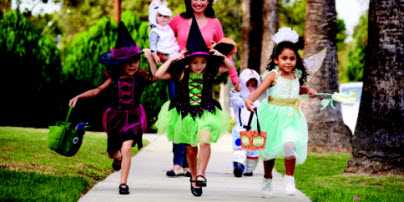Halloween can be a fun and exciting time for children of all ages. To ensure it’s also a safe experience, parents and caregivers are encouraged to follow these important safety tips.
Costume and decoration safety:
• Be sure to check Health Canada’s Recalls and Safety Alerts database to ensure your costumes, decorations (such as string lights) and accessories have not been recalled.
• Look for costumes and accessories (such as beards, wigs, wings and tails) that are labelled as “flame-resistant.” Flowing skirts and capes, baggy sleeves, over-sized costumes and feathers on costumes can all be hazards around candles or flames. Nylon or heavyweight polyester costumes are best.
• Remember, flame-resistant does not mean fire-proof! To further reduce the risk around open flames, consider using LED candles or lights in your jack-o-lantern and decorations.
• Make sure that costumes are loose enough to be worn over warm clothing, but not so baggy or long that children could trip over them.
• Pick brightly coloured costumes that can be seen clearly by motorists. Add reflective tape to the costume to increase visibility.
• Consider using make-up or face paint instead of masks, as improperly fitted masks can interfere with your child’s vision or breathing. If you do choose to use a mask, make sure it is one that allows the child to see and breathe easily.
• Before using face paint or make-up, do a patch test to see whether your child is sensitive or allergic to something in the cosmetic. Products labelled as “hypoallergenic” can still cause allergic reactions.
Trick or treating:
• Give each child a flashlight to carry to make them more visible to motorists and others.
• Tell your children to stay in well-lit areas and to visit only homes that have their outside lights turned on. Remind children not to go inside homes or cars, even if they are invited.
• Remind children not to eat any treats until you have checked them first.
• Throw out treats that are not commercially wrapped, or are found in torn, damaged or loose packages.
• Ask children to wash their hands before opening and eating candy treats.
• Remove any choking hazards like gum, peanuts, hard candies or small toys from the loot bags of young children. Do not let children younger than three years of age play with toys with small parts.
Tips for parents of children with food allergies or sensitivities:
• Consider giving out treats that do not contain ingredients like peanuts, tree nuts, milk and egg. These ingredients can cause severe reactions in individuals who have allergies or sensitivities.
• If your child has food allergies, read labels carefully and avoid candies that do not have an ingredient list, or that have a “may contain” statement that lists ingredients to which he/she is allergic.
• If your child has been prescribed an epinephrine auto-injector because of a food allergy, make sure he/she has it available whenever he/she eats.



